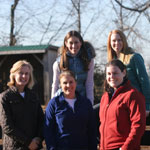
When writer Lisa Savage started teaching her teenage daughter to drive, she found many parallels between driving a car and riding a horse.
My daughter started riding horses when she was 8 years old. At that time, learning to drive a car was not something we thought about much, though we did have friends who told us stories about their teens’ driving experiences. Little did I know how much riding lessons would come in handy when it came to driving lessons!
- Eyes Up. It can be easy to get distracted by adjusting the radio or climate control, or any number of things in the car. Like riding, if you don’t look ahead to see where you’re going, you might lose direction and control. Yes indeed, “eyes up” was a riding-to-driving teaching point that came in handy often.
- Don’t get too close. All those flat-class techniques sure came in handy when I was teaching my daughter to keep a safe distance from the car in front of her. Though vehicles don’t have red ribbons on their bumpers, the idea is the same.
- Give that guy lots of room. This is similar to “don’t get too close” but is more specific to the behavior of other drivers. Back to the flat classes again: If someone is weaving in and out, tailgating, or otherwise driving like they’re the only car on the road (or horse on the rail), it’s time to practice avoidance behavior!
- Stay out in your turn. This is my favorite because it was the first trainer speak to come out of my mouth during a driving lesson. We were at a traffic light where two lanes turned left, and we were in the outside lane. Perfect. Like using the corners on course, stay out in your turn.
- Find the distance. We live in a subdivision that requires merging onto a busy, two-lane road to go anywhere. There is no traffic light, so you must judge how far away the oncoming traffic is and calculate the distance. Too close? An easy fit? The riding-arena analogy worked great. Instead of counting strides, we counted seconds.
- Stop smoothly. Easy does it; make it smooth. No jerking, please. Different cars, like horses, stop differently. There are no voice commands for a car, but I could compare the coordination required to halt a horse to applying the brakes on a car. (Although, I probably wouldn’t be the first parent to say “whoa” from the passenger’s seat.)
- Commit to moving forward. A trainer once shouted this advice to a ring full of young riders, and it has resonated with me for years. I have found it applicable to many situations in life, including merging into traffic on a freeway or other high-speed road.
- Take care of your vehicle. Whether it’s daily maintenance or dealing with a breakdown, the equipment needs TLC. You must maintain your ride so that it’s in good shape to carry you around safely. Some things are scheduled maintenance and other things just come up. Vet bills or mechanic bills—take your pick. Either way, you have to take good care of your transportation.
While my daughter would rather be on her horse than in her car, she enjoys both immensely. She is a good driver and seemed to be a natural behind the wheel from the beginning. I knew that riding was good for her in many ways, and now there’s one more thing to count among them. Our auto insurer wouldn’t consider an “experience” discount based on her time in the saddle, but we know that her riding expertise has made learning to drive a bit easier. Plus, the driver’s license means she can take herself to the barn and spend more time there when she goes, which is probably her favorite part of being street legal. So, the next time your barn bill arrives, you can count your blessings and know that there is more than one reason that it’s money well-spent!
Liked this article? Here are others you’ll enjoy:
10 Life Lessons Learned from Jumping Horses
Lessons from Ruby
This article originally appeared in the June 2014 issue of Horse Illustrated magazine. Click here to subscribe!
Be a part of “Your Horse Life”! Send story submissions to horseillustrated@luminamedia.com.






great info